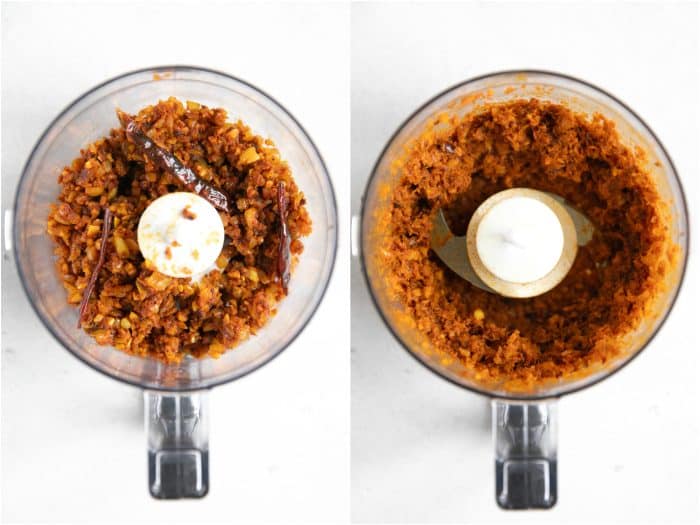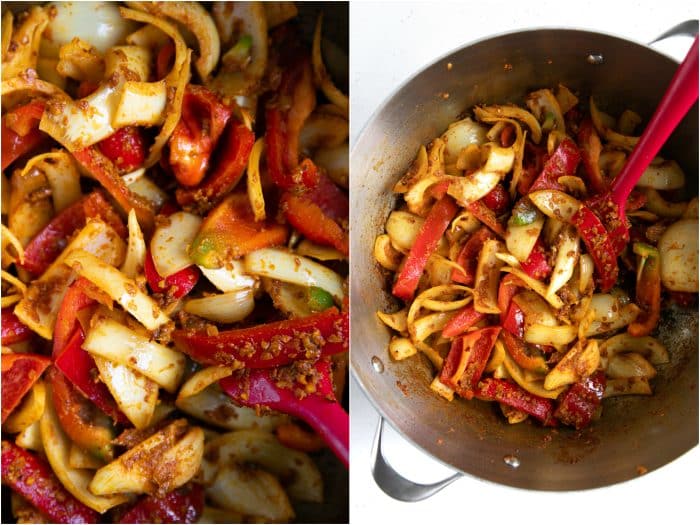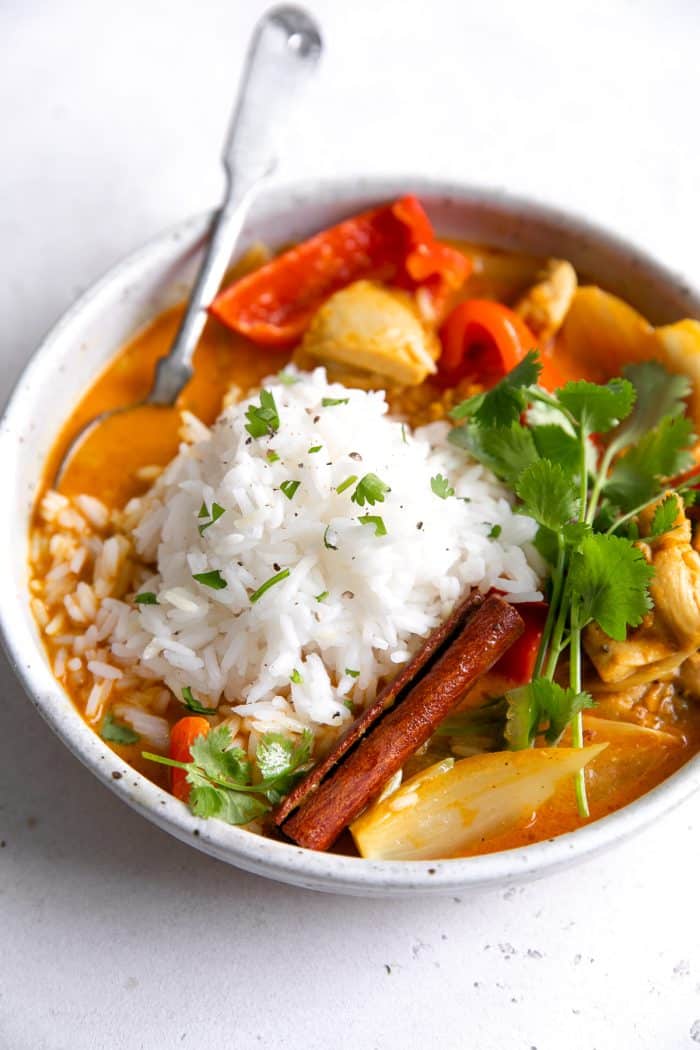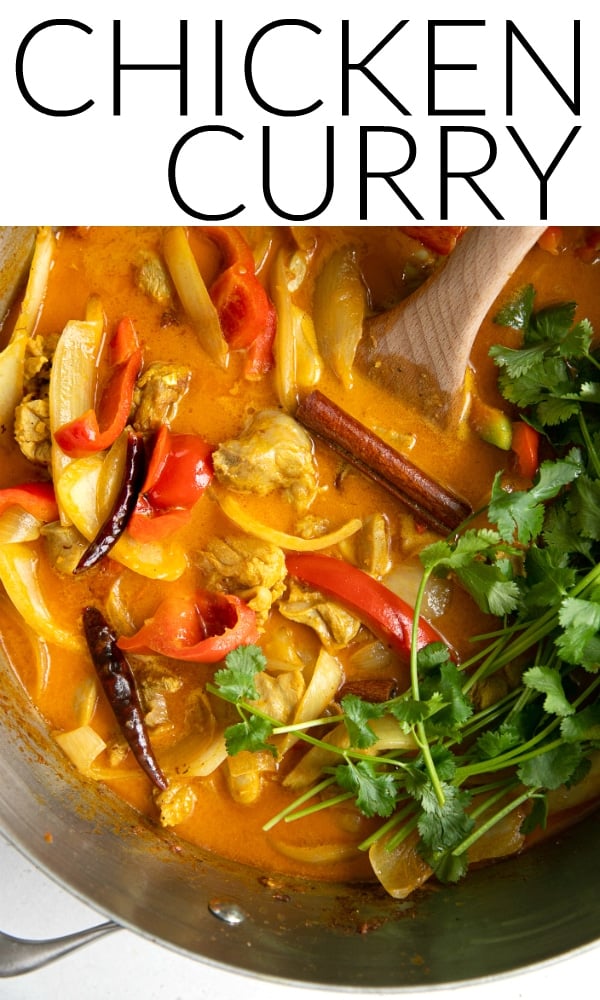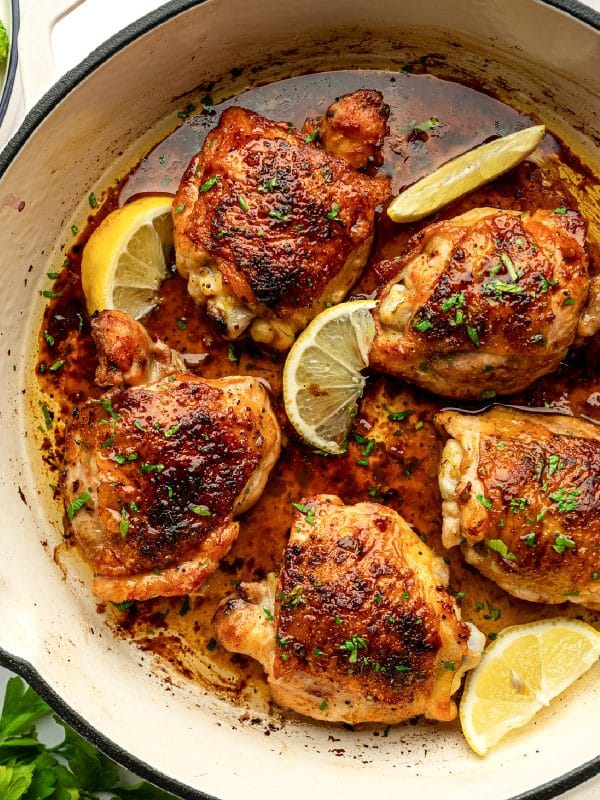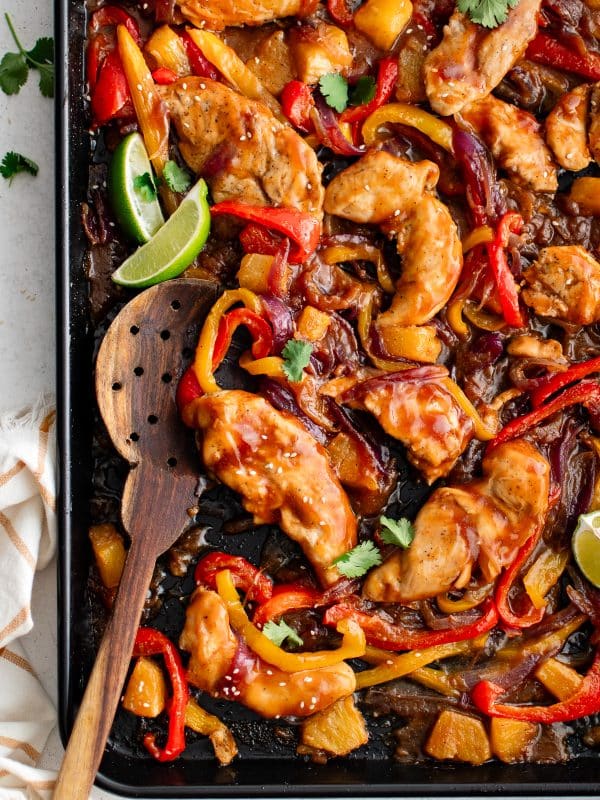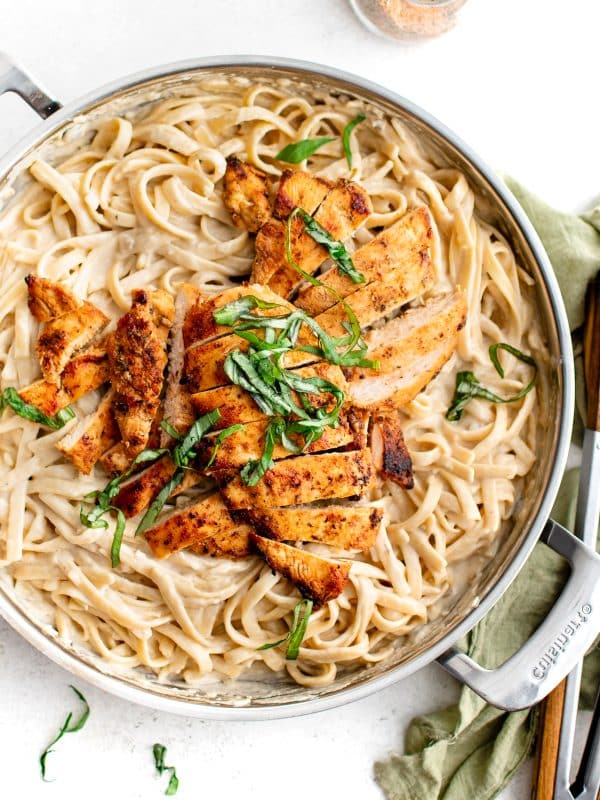This post may contain affiliate links. See my disclosure policy.
This Chicken Curry Recipe, made with a simple and homemade curry paste, is anything but boring. Creamy, fragrant, and colorful, this chicken curry, bursting with mouthwatering Thai and Indian flavors and spices, is guaranteed to be your favorite curry recipe- guaranteed!
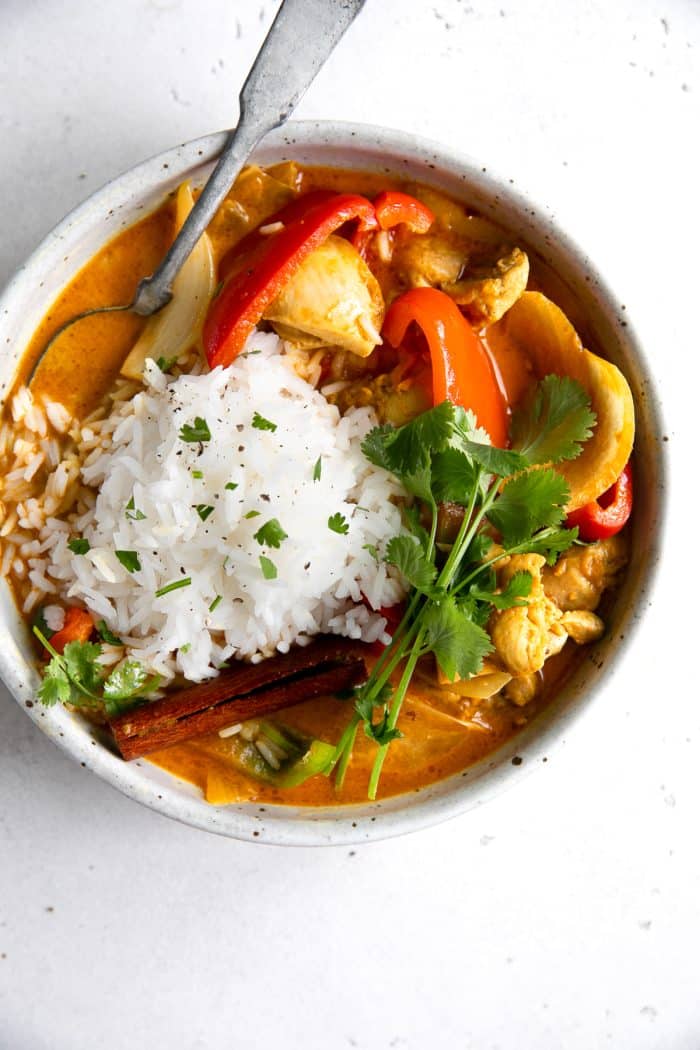
The Best Chicken Curry Recipe
This chicken curry happened by accident. Err, maybe not entirely, but mostly. The short story? I wanted to give you guys an awesome chicken curry recipe (from scratch!!!) that didn’t call for too many hard-to-find ingredients (like lemongrass or Thai basil). This chicken curry was the result and let me tell you – you’re going to love it! Here’s why:
- So much flavor. I’m always so disappointed by the jarred curry pastes or curry sauces sold in most grocery stores. They’re bland and boring and not worth the convenience.
- The ingredients are simple. The most unusual thing you’ll find in here are the whole cardamom pods, dried Thai red chilis, and fish sauce (but even Trader Joes carries fish sauce).
- It’s spicy! Which makes me really happy, of course, but if spicy foods aren’t your thing…
- It’s a super easy recipe to modify. More heat, less heat, no heat? You choose.
- You don’t have to make your chicken curry all at one time. Marinate your chicken and prepare your curry paste a day or two ahead. So easy!
- Finally, if you really don’t want to make your own curry paste or you don’t have the time, that’s ok. Simply skip the homemade curry paste and substitute with your favorite store-bought version.
Not sure if this is the chicken curry recipe for you? You may also enjoy this healthy vegetarian cauliflower tikka masala or my rich and creamy butter chicken recipe.
What is Chicken Curry?
Chicken curry, sometimes called curry chicken when referring to Caribbean curries, comes in many forms. Originating from the Indian subcontinent, and brought to SE Asia, the Caribbean, and Great Britain, most chicken curries typically contain, well, chicken, but also a range of aromatics and spices, chilies, tomatoes, and either cream or coconut milk.
In the Indian subcontinent where chicken curry originated there is a large regional variation between ingredients. In the north, for example, it may be cooked with extra spices, some may be sweeter, while others may be extra rich and creamy due to the addition of extra butter or cashew nuts. Head to southern India and rather than butter and cashews, chicken curry may be thickened using coconut milk.
How to Make Chicken Curry
Since this curry isn’t made with a pre-made curry paste and I DO highly recommend marinating your chicken in yogurt and spices, it does take a bit longer to prepare and cook when compared to “quick-cook” curries like this 30-minute Pineapple Coconut Thai Fish Curry.
But don’t worry- it’s worth it. Plus, it’s easily prepared and cooked in steps that can be done all at the same time or at different times.
For the full list and amounts of ingredients, scroll down to the recipe card at the bottom of the page.
Step 1. Marinate your chicken
- Add the yogurt, curry powder, paprika, ground cinnamon, and salt to a large bowl. Whisk well to combine and add the chicken. Mix well to completely coat the chicken pieces in yogurt.
- Allow the chicken to marinate for at least 30 minutes. If you plan to marinate your chicken for longer, cover the bowl with plastic wrap and transfer to the refrigerator for up to 2 days.
Can you use chicken breasts instead of chicken thighs?
Yes, of course! If you choose to use boneless skinless chicken breasts to make this chicken curry recipe keep in mind that they are lower in fat when compared to chicken thighs. Due to this, it’s really important not to overcook your chicken.
Step 2 – Prepare the curry paste
There are two parts to making this curry paste, cooking the aromatics and spices first, followed by pureeing it all together.
First cook:
- Place a large heavy-bottomed pan over medium heat. Add the cinnamon sticks and cardamom pods to the pan and toast over dry heat for 2-3 minutes, or until fragrant, reducing the heat if needed to prevent them from burning. Remove from the pan and set aside (you’ll add them back in a sec).
- Add 2 tablespoons vegetable or peanut oil to the pan and set over medium-high heat. Add the diced onion and cook for 2-3 minutes, stirring often. You don’t want to cook the onion until they’re mushy, just long enough to start the cooking process.
- Mix in the garlic and ginger and sauté for an additional 1 minute.
- Return the toasted cinnamon sticks and cardamom pods, plus the Thai red chilis, to the pan, and mix well to combine. Continue to cook for 2-3 minutes, stirring often.
- Reduce heat to medium and combine the tomato paste with the aromatics. Cook, stirring continuously, for 1-2 minutes. Remove from heat.
Then process:
- Remove the cardamom pods and cinnamon sticks (remember how many you put in there) and set aside.
- Transfer the remaining ingredients to a small food processor. Process until a thick paste is formed, scraping down the sides as needed. Transfer to a jar or container with a tight-fitting lid.
How to store leftover curry paste:
The best part about this red curry paste is that you can make it ahead of time and keep it store in the refrigerator for up to 1-2 weeks or in the freezer for up to one month! Easy and super convenient, right?
Step 3 – Put it all together and cook
Brown the chicken, first:
- Over high heat, add 1 tablespoon oil to the same heavy-bottomed pan or Dutch oven used to cook the aromatics. Once hot, add the chicken in a single layer and cook for 2-3 minutes on each side, or until brown and just starting to char. Don’t worry about shaking off all the marinade before adding it to the pan- it’s flavor!
- Remove chicken to a clean plate and set aside. Don’t worry if the chicken is not fully cooked on the inside. You’ll be cooking it again in a minute.
- Scrape out any charred bits stuck to the bottom of the pan and repeat process until all chicken has been cooked (it took me 2 rounds).
Put it all together:
- Return pot to medium-high heat. Add the remaining oil and the onions. Cook until just starting to soften then add the bell peppers, salt, water (or chicken broth), 4-6 tablespoons of the prepared curry paste, and the reserved cinnamon sticks and cardamom pods. Thoroughly mix and cook, stirring often, for 2-3 minutes.
- Next, stir in the coconut milk. Increase heat to high and bring to a simmer.
- Immediately reduce heat to medium and add the browned chicken to the pot. Add the sugar and fish sauce, mixing well to combine. Allow chicken and vegetables to simmer for 2-3 minutes, uncovered.
- Season with additional salt, sugar, curry paste, or fish sauce, to taste, and garnish with fresh cilantro (coriander leaves), if desired.
Variations
Just a few tips and tricks to help you make the very best chicken curry ever!
Make it mild: Can chicken curry not be spicy? Yes! The heat in this coconut curry dish comes from those cute little dried Thai red chilis. You have a few options here,
- Add less or none at all.
- Cook with them until it comes time to blend the curry paste. Rather than puree the whole thing split them open, remove the seeds, and only blend the chili pod.
- Skip the dried Thai red chilis and add a teaspoon of red chili flakes instead.
Make it lighter: To be honest, I don’t really recommend this. A chicken curry that contains coconut milk should be made with the full-fat stuff, not the lightened up, watered-down kind. That said, it’s an option if you’re looking for a lighter meal. You can also add a single a single can of coconut milk or coconut cream rather than two. Water down with chicken broth or enjoy as a thicker curry.
Add your favorite veggies: Onions and bell peppers are what felt right at the time of making this curry, but they’re definitely not the only options you have. Broccoli, squash, cauliflower, or dark leafy greens are all great.
Pump up the protein: I need a lot of protein. Sometimes I’ll add a can or two of drained chickpeas for an extra punch of protein without adding more meat.
Finally, this is not a soup. Do not simmer your veggies and chicken for much longer than 5-10 minutes (at most!!!) You want your veggies to have a small bite left to them. As for the chicken? It dries out the longer it cooks.
More Chicken Recipes,
Poached Chicken Breasts (How to Poach Chicken)
If you try making this Chicken Curry Recipe, please leave me a comment and let me know! I always love to hear your thoughts.
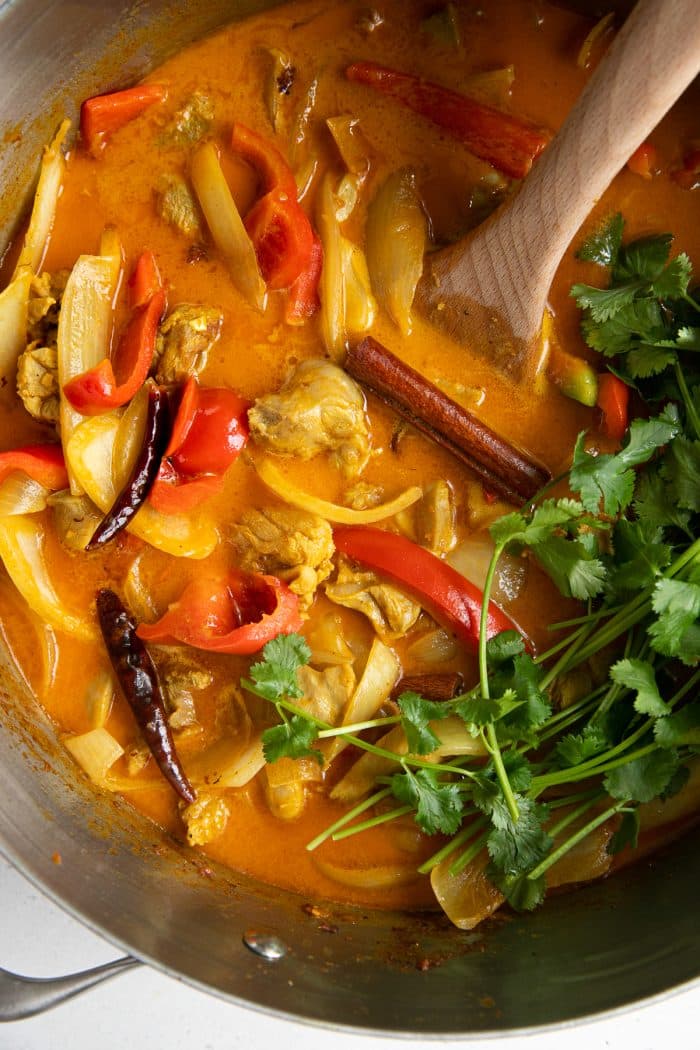
Chicken Curry Recipe
Ingredients
For the Marinade + Chicken
- 2 tablespoon curry powder
- 1 cup plain yogurt
- 1 teaspoon paprika
- 1 teaspoon ground cinnamon
- 1 teaspoon salt
- 2 pounds boneless skinless chicken thighs, chopped into bite-size pieces
For the Curry Paste
- 2 cinnamon sticks
- 3 whole cardamom pods
- 2 tablespoon oil
- 1 white or yellow onion, minced
- 5 cloves garlic , roughly chopped
- 1 3-inch piece fresh ginger, peeled and chopped
- 8 dried Thai red chilis
- 3 tablespoon tomato paste
For the Chicken Curry
- 3 tablespoon oil
- 1 large white onion, peeled and sliced thick
- 2 bell peppers, seeded and sliced root to tip
- 1 teaspoon salt
- 1 cup water, or broth
- 4-6 tablespoon prepared curry paste
- 2 (15 ounce) cans coconut milk, (or coconut cream)
- 1 tablespoon granulated sugar
- 1 tablespoon fish sauce, (plus more as needed - I always add more)
- fresh cilantro, to garnish
Instructions
For the Marinade + Chicken
- Add the yogurt, curry powder, paprika, ground cinnamon, and salt to a large bowl. Whisk well to combine. Add the chicken and mis well to coat.
- Cover the bowl with plastic wrap and transfer to the refrigerator to marinate for at least 30 minutes or up to 2 days.
For the Curry Paste
- Place a large heavy-bottomed pan over medium heat. Add the cinnamon sticks and cardamom pods to the pan and toast over dry heat for 2-3 minutes, or until fragrant, reducing the heat if needed to prevent the spices from burning. Remove from the pan and set aside.
- Add 2 tablespoons vegetable or peanut oil to the pan and set over medium-high heat. Add the diced onion and cook for 2-3 minutes, stirring often. Mix in the garlic cloves and ginger and cook for an additional 1 minute.
- Return the toasted cinnamon sticks and cardamom pods, plus the Thai red chilis, to the pan, and mix well to combine. Continue to cook for 2-3 minutes, stirring often.
- Reduce heat to medium and combine the tomato paste with the aromatics. Cook, stirring continuously, for 1-2 minutes. Remove from heat.
- Remove the cardamom pods and cinnamon sticks and set aside. Transfer the remaining ingredients to a small food processor. Process until a thick paste is formed. Set aside or transfer to a sealed container and keep refrigerated for up to 1 week.
For the Chicken Curry
- Over high heat, add 1 tablespoon oil to the same heavy-bottomed pan or Dutch oven used to cook the aromatics. Once hot, add the chicken in a single layer and cook for 2-3 minutes on each side, or until brown and just starting to char. Remove chicken to a clean plate and set aside (do not worry if the chicken is not fully cooked on the inside).
- Scrape out any charred bits stuck to the bottom of the pan and repeat process until all chicken has been cooked (it took me 2 rounds).
- Wipe down the pot, or clean as needed, and return to medium high heat.
- Add 1 tablespoon of oil to the pan and add the onions. Cook for 1-2 minutes, stirring frequently. Add the bell peppers, salt, water (or broth), 4-6 tablespoons of the prepared curry paste, and the reserved cinnamon sticks and cardamom pods. Thoroughly mix to combine and cook, stirring often, for 2-3 minutes.
- Stir in the coconut milk and mix thoroughly. Increase heat to high and bring to a simmer.
- Immediately reduce heat to medium and return the browned chicken to the pot. Add the sugar and fish sauce, mixing well to combine. Allow chicken and vegetables to simmer for 2-3 minutes, uncovered.
- Season with additional salt, sugar, curry paste, or fish sauce, to taste. Serve with cooked basmati rice, jasmine rice, or noodles or thick, fluffy naan bread, if desired.
Notes
Nutrition
Nutrition information is automatically calculated, so should only be used as an approximation.





